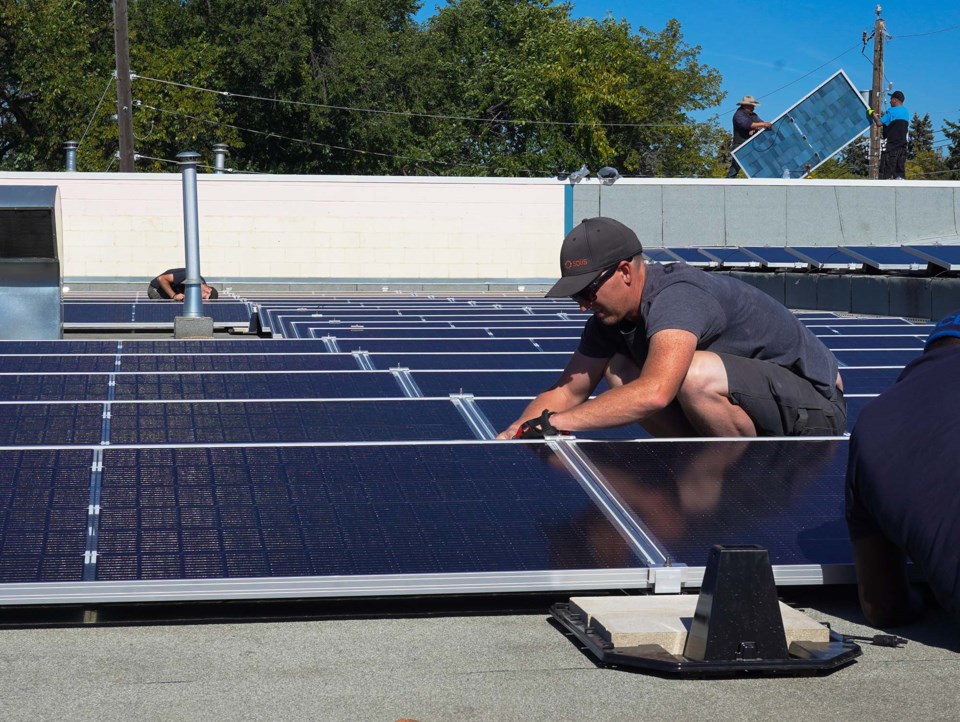Neighbours for climate
The Gazette is using the City of Edmonton’s Neighbouring for Climate guide to help St. Albert streets fight back against climate change. Check out the guide at edmonton.ca/climateneighbours.
Solar power is one of the most visible and direct ways to prepare your neighbourhood for global heating. Those shiny rooftop arrays produce power which you can use to run cars, heat homes, and save money, all without the air pollution and extreme weather caused by fossil fuel generators. Pair them with a battery storage system, and you can even keep your house powered during a blackout.
“Solar is not only going to help reduce your own energy bills but it will obviously lessen your impact on the environment,” said Heather MacKenzie, executive director for Solar Alberta.
Gordon Howell of Howell Mayhew Engineering (who has designed and built solar PV systems in Alberta for decades) estimates that a 6 kW solar system can power the average Alberta home and would cost about $17,000 to build. Assuming an electricity price of about 15.6 cents/kWh (the average regulated rate for electricity from Epcor in 2022), such a system would pay for itself in about nine years with the $5,000 federal Greener Homes grant for solar and 13 without it. You could also get such a system for no money down through the Clean Energy Improvement Program in St. Albert.
Rooftop arrays require basically zero maintenance, although you should ensure your installation and equipment come with robust warranties, MacKenzie said.
“I’ve had solar for three years now and I haven’t had to touch it,” she said of her array.
If you combine your array with on-site storage (which is expensive), you can become a “solar block parent” for your neighbourhood and provide electricity during a blackout, MacKenzie said. Not many people do this, though, as Alberta has a pretty reliable power grid.
The Neighbouring for Climate guide suggests working with your neighbours to scout out roofs and other locations for solar and hiring one company to do installs to save on economies of scale. You can also use websites like MyHEAT Solar to spot potential good spots for panels in Edmonton and St. Albert.
The co-op option
But what if you can’t afford a full solar array, or don’t have a big open roof for it? Could you team up with your neighbours and put an array on that local church or hockey rink instead?
You can with a solar co-op. A co-op is a business owned and operated by its members who benefit from its goods or services.
Solar co-ops are more like a traditional investment than rooftop solar, MacKenzie said. Instead of getting a direct credit on your electricity bill, you get dividends from your investment, which in turn could lower your energy costs.
While you could start your own co-op with your neighbours, you’re probably better off joining an existing one due to all the bylaws, board members, and administrators involved. Two of the most developed solar co-ops in Alberta as of this writing are the Bow Valley Green Energy Cooperative and the Solar Power Investment Cooperative of Edmonton (SPICE). You can sign up with either group online.
Once you’ve signed up with a co-op, you and other co-op members can approach a property owner (typically a business or community group) to see if they want to host a solar array, explained Sue Hayduk, director of membership and engagement with the Bow Valley co-op. The co-op does a feasibility study, raises funds from its members and grants, and arranges for the array’s construction. The building owner saves money on energy while the investors earn returns on their investment.
SPICE’s first project is a roughly 30 kW system atop the Bissell Thrift Store in Edmonton, said manager Annette Dautel. The system should cut the store’s electricity costs by 60 per cent once operational, giving the Bissell Centre more cash to fight poverty, and prevent about 22 tonnes of heat-trapping pollution a year (equivalent to keeping five cars off the road, the U.S. EPA reports). The project is also giving Bissell Centre clients job training they can use to get into the solar industry.
“It’s genuinely from the community, for the community,” Dautel said of the project.
Dautel said SPICE hopes to start another five or 10 projects next year in the greater Edmonton region.
The Bow Valley co-op has four arrays in operation atop churches and commercial buildings in southern Alberta with two more in the works, its website reports. The arrays generate renewable electricity and prevent some 355 tonnes of heat-trapping pollution a year (about 79 cars taken off the road, the U.S. EPA estimates).
Solar co-ops keep money in your community, cut heat-trapping pollution, and show climate leadership, Hayduk said.
“You’re leading change and showing others this can be done.”
Visit solaralberta.ca for more on solar and solar co-ops.




